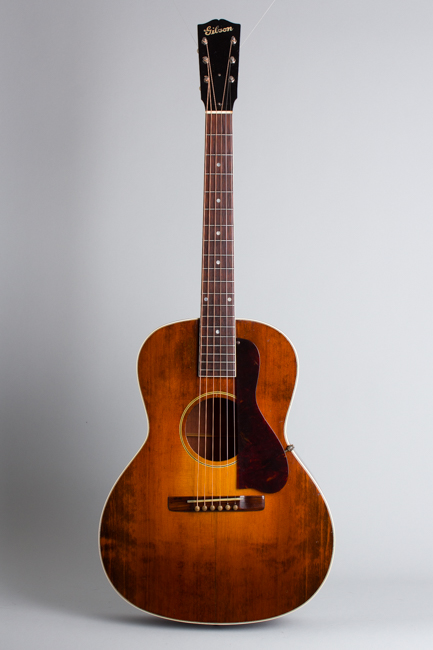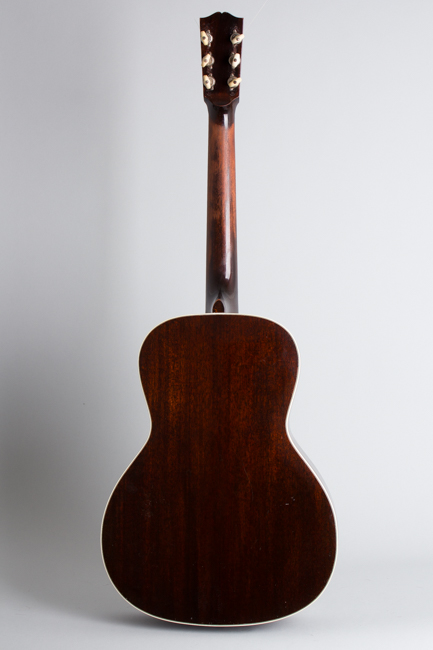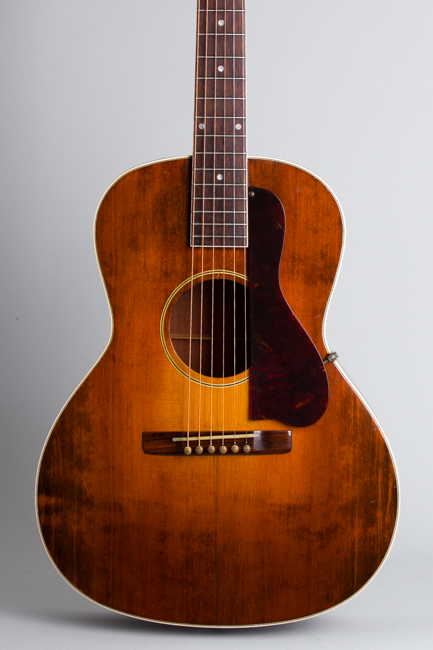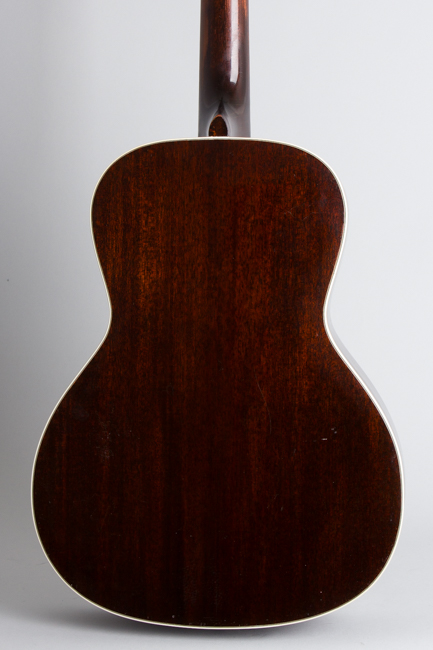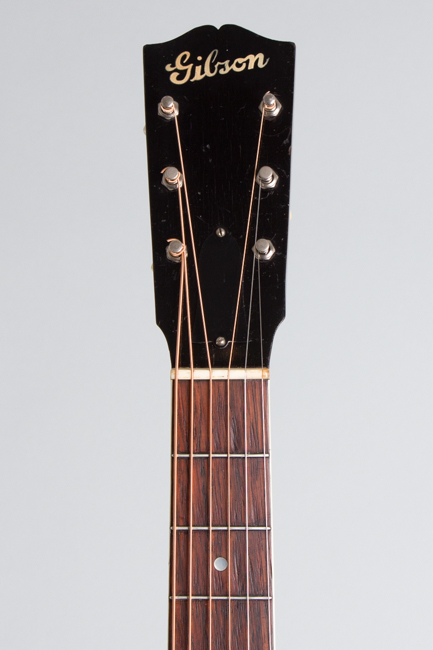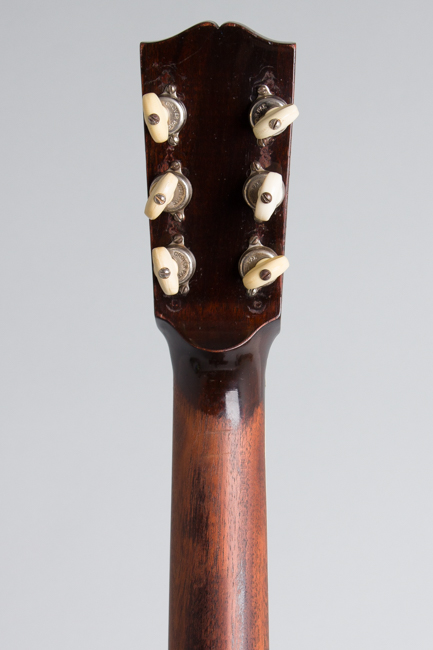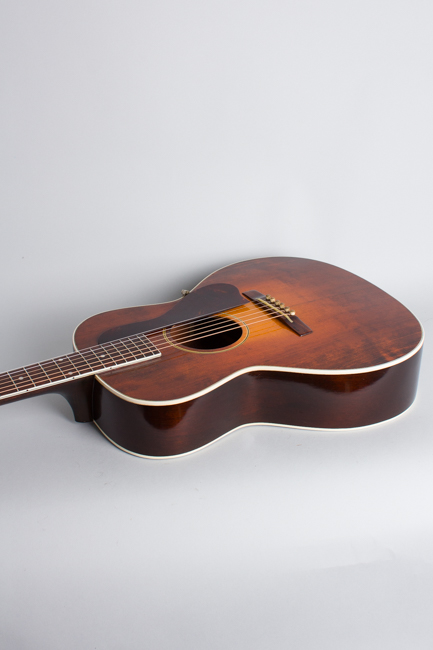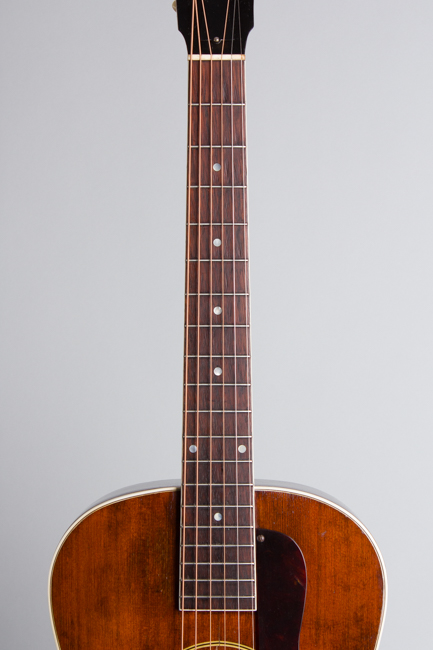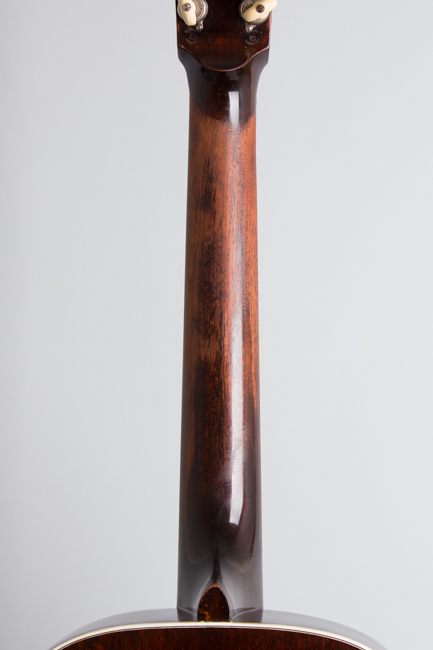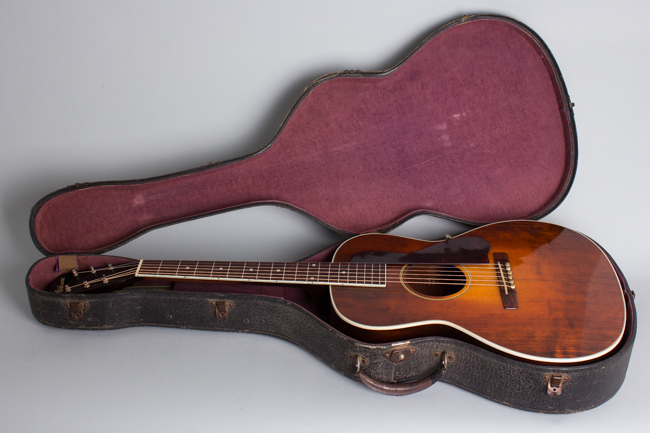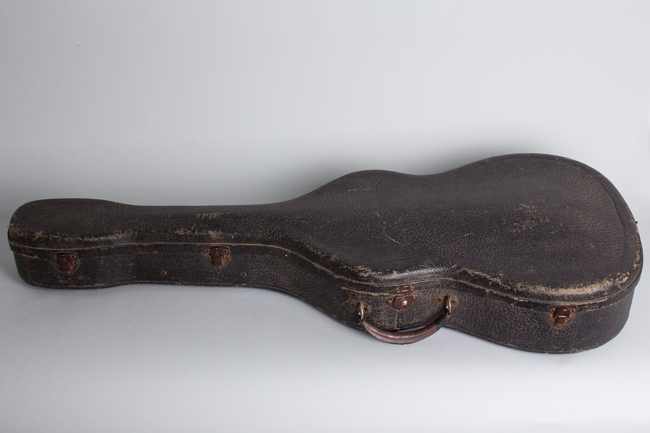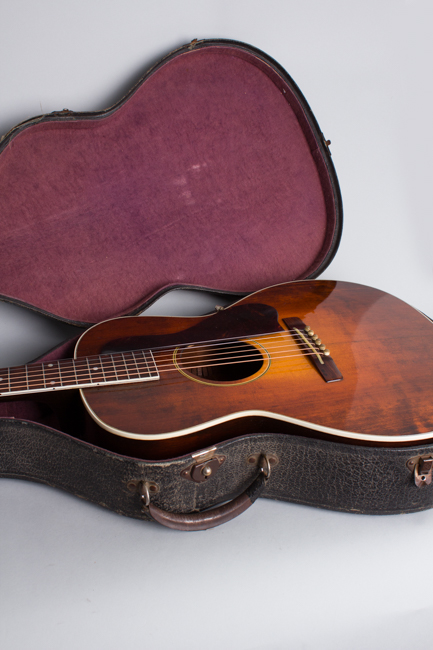Gibson L-2 Flat Top Acoustic Guitar (1930)
This item has been sold.
Item # 11992
Prices subject to change without notice.
Gibson L-2 Model Flat Top Acoustic Guitar (1930), made in Kalamazoo, Michigan, serial # 9505 (FON), sunburst top, dark mahogany back and sides finish, mahogany back and sides spruce top; mahogany neck with rosewood fingerboard, original black hard shell case.
This is one of the odder Gibson L-2's we have seen, which is saying something as the flat-top L-2 in general is one of Gibson's more inconsistent and ephemeral creations. This model was offered only over a brief period between 1929 and 1933 in a confusing array of woods, finishes and appointments. Over this short production life several distinctly different L-2's were issued, as if the company could not decide on a permanent design for $75 flat top model, second only to the $125 Nick Lucas Special. Some were rosewood, some mahogany, some had tailpieces, some pin bridges and the cosmetics varied seemingly with the wind. They all share the then-new nearly 15" wide, less round-bottomed body introduced in 1929 and an X-braced spruce top, first employed around 1928. These features would continue to be used on large numbers 14-fret L-series guitars throughout the 1930s.
According to the Factory Order Number on the neck block this particular guitar was originally built right at the beginning of 1930, from one of the earliest L-2 batches built (possibly the second, but the information is incomplete). It has an especially odd mix of features, some suggesting it was either finished out some time after being initially fabricated or possibly returned early on for factory service. While the latter is possible, we have seen another nearly identical L-2 from the first known batch which wound more strongly support the former conclusion. Gibson sales were in free-fall at the time, and instruments from this period sometimes manifest inconsistent features suggesting a time lag between fabrication and eventual sale.
The neck joins the body at the 13 fret, an odd and short-lived Gibson halfway house between 12 and 14-fret designs. The neck itself is unusual with a fairly thick round-backed profile and a banjo-like volute on the back of the headstock. It looks and feels much like the neck used on the 1920s GB-3 Banjo-Guitar, a similarity enhanced by Grover banjo tuners on the headstock! The dot inlaid rosewood fingerboard is single bound with a side line. The white "Gibson" headstock logo is a style that shouldn't exist until around 1932 yet the guitar is part of that very early 1930 batch.
The back and sides are mahogany, the top is tight grained spruce. It features *exceptionally* light construction, even compared to other pre-war Gibsons. The X bracing has delicate non-scalloped main braces thinner than even period Martins. This guitar appears to have been originally built with a pin bridge and not converted later (there are L-2's with original tailpieces). Although there are tiny holes on the rim from a previous tailpiece they do not match the unit Gibson used at the time. The elevated celluloid pickguard is original, pre-dating the glued on one used by 1932.
The top finish on this guitar has an unusual look as well; it is stained like the 1920s Cremona brown but is unusually spotty and inexactly applied. It absolutely appears to be period Gibson work, just not exactly what one would expect in the way the shading under the lacquer was blended. Perhaps the finishing department was in flux at the time. The back and sides are a darker mahogany stain. There are no signs of added or altered finish either under natural or blacklight examination.
This entire guitar is enigmatic but as the L-2 was built in multiple variations but only limited numbers some of the history is simply guesswork. As a very expensive flattop at the onset of the depression the market for these was pretty slim. Several other variants offered over the next few years are more common but this edition appears to be about the rarest. It also happens to be a wonderful playing and sounding instrument, with light construction throughout and a huge but engagingly sweet tone.
Overall length is 40 in. (101.6 cm.), 14 3/4 in. (37.5 cm.) wide at lower bout, and 4 3/8 in. (11.1 cm.) in depth at side, taken at the end block. Scale length is 24 3/4 in. (629 mm.). Width of nut is 1 3/4 in. (44 mm.).
This original 90+ year old L-2 is not absolutely pristine but extremely well preserved for an early Gibson flat top. These 1930-era instruments are *very* lightly constructed and most survivors are heavily worn and/or rebuilt. This guitar has some very finely executed maintenance repairs but remains completely intact and an excellent player.
The original thin lacquer finish has some typical checking and small dings, dents and scrapes overall but the only heavily worn area is the back of the neck, down to the wood over much of its length. Overall the finish presents nicely with none of the heavy pick marks usually seen on older flat tops, just mostly minor dings and scratches. The back has some light "strap burn" on the lower center areas. The back of the headstock shows signs of several different tuner installations, but the original tabbed Grover tuners have been restored and work as well as they ever did.
Internally the guitar is nicely preserved, with all original bracing and the original thin maple bridgeplate intact and unaltered. There are small thin cleat strips along most of the center seam, which has been resealed along much of its length. There are a couple of very small cleats to a grain split below the pickguard, no other cracks are evident. As noted there are three tiny filled pinholes in the rim above the endpin from an ancient tailpiece addition. The bridgepins are original, the endpin is not.
The neck angle is good, the rosewood pin bridge is a very nice repro of the original (the remains of which are still in the case). The neck has never been reset or refretted; the original thin wire has been polished out a bit. This guitar is a very nice player; eccentric perhaps (13 fret neck joint, anyone?) but a lovely instrument nonetheless. The sound is a bit barkier than some L's from this era, quite loud and equally at home flat-or fingerpicked. It still resides in the original HSC, still intact with a couple of latches no longer sprung. This is simply a delightful enigma of a Gibson from one of the company's finest eras. Excellent - Condition.
This is one of the odder Gibson L-2's we have seen, which is saying something as the flat-top L-2 in general is one of Gibson's more inconsistent and ephemeral creations. This model was offered only over a brief period between 1929 and 1933 in a confusing array of woods, finishes and appointments. Over this short production life several distinctly different L-2's were issued, as if the company could not decide on a permanent design for $75 flat top model, second only to the $125 Nick Lucas Special. Some were rosewood, some mahogany, some had tailpieces, some pin bridges and the cosmetics varied seemingly with the wind. They all share the then-new nearly 15" wide, less round-bottomed body introduced in 1929 and an X-braced spruce top, first employed around 1928. These features would continue to be used on large numbers 14-fret L-series guitars throughout the 1930s.
According to the Factory Order Number on the neck block this particular guitar was originally built right at the beginning of 1930, from one of the earliest L-2 batches built (possibly the second, but the information is incomplete). It has an especially odd mix of features, some suggesting it was either finished out some time after being initially fabricated or possibly returned early on for factory service. While the latter is possible, we have seen another nearly identical L-2 from the first known batch which wound more strongly support the former conclusion. Gibson sales were in free-fall at the time, and instruments from this period sometimes manifest inconsistent features suggesting a time lag between fabrication and eventual sale.
The neck joins the body at the 13 fret, an odd and short-lived Gibson halfway house between 12 and 14-fret designs. The neck itself is unusual with a fairly thick round-backed profile and a banjo-like volute on the back of the headstock. It looks and feels much like the neck used on the 1920s GB-3 Banjo-Guitar, a similarity enhanced by Grover banjo tuners on the headstock! The dot inlaid rosewood fingerboard is single bound with a side line. The white "Gibson" headstock logo is a style that shouldn't exist until around 1932 yet the guitar is part of that very early 1930 batch.
The back and sides are mahogany, the top is tight grained spruce. It features *exceptionally* light construction, even compared to other pre-war Gibsons. The X bracing has delicate non-scalloped main braces thinner than even period Martins. This guitar appears to have been originally built with a pin bridge and not converted later (there are L-2's with original tailpieces). Although there are tiny holes on the rim from a previous tailpiece they do not match the unit Gibson used at the time. The elevated celluloid pickguard is original, pre-dating the glued on one used by 1932.
The top finish on this guitar has an unusual look as well; it is stained like the 1920s Cremona brown but is unusually spotty and inexactly applied. It absolutely appears to be period Gibson work, just not exactly what one would expect in the way the shading under the lacquer was blended. Perhaps the finishing department was in flux at the time. The back and sides are a darker mahogany stain. There are no signs of added or altered finish either under natural or blacklight examination.
This entire guitar is enigmatic but as the L-2 was built in multiple variations but only limited numbers some of the history is simply guesswork. As a very expensive flattop at the onset of the depression the market for these was pretty slim. Several other variants offered over the next few years are more common but this edition appears to be about the rarest. It also happens to be a wonderful playing and sounding instrument, with light construction throughout and a huge but engagingly sweet tone.
Overall length is 40 in. (101.6 cm.), 14 3/4 in. (37.5 cm.) wide at lower bout, and 4 3/8 in. (11.1 cm.) in depth at side, taken at the end block. Scale length is 24 3/4 in. (629 mm.). Width of nut is 1 3/4 in. (44 mm.).
This original 90+ year old L-2 is not absolutely pristine but extremely well preserved for an early Gibson flat top. These 1930-era instruments are *very* lightly constructed and most survivors are heavily worn and/or rebuilt. This guitar has some very finely executed maintenance repairs but remains completely intact and an excellent player.
The original thin lacquer finish has some typical checking and small dings, dents and scrapes overall but the only heavily worn area is the back of the neck, down to the wood over much of its length. Overall the finish presents nicely with none of the heavy pick marks usually seen on older flat tops, just mostly minor dings and scratches. The back has some light "strap burn" on the lower center areas. The back of the headstock shows signs of several different tuner installations, but the original tabbed Grover tuners have been restored and work as well as they ever did.
Internally the guitar is nicely preserved, with all original bracing and the original thin maple bridgeplate intact and unaltered. There are small thin cleat strips along most of the center seam, which has been resealed along much of its length. There are a couple of very small cleats to a grain split below the pickguard, no other cracks are evident. As noted there are three tiny filled pinholes in the rim above the endpin from an ancient tailpiece addition. The bridgepins are original, the endpin is not.
The neck angle is good, the rosewood pin bridge is a very nice repro of the original (the remains of which are still in the case). The neck has never been reset or refretted; the original thin wire has been polished out a bit. This guitar is a very nice player; eccentric perhaps (13 fret neck joint, anyone?) but a lovely instrument nonetheless. The sound is a bit barkier than some L's from this era, quite loud and equally at home flat-or fingerpicked. It still resides in the original HSC, still intact with a couple of latches no longer sprung. This is simply a delightful enigma of a Gibson from one of the company's finest eras. Excellent - Condition.
